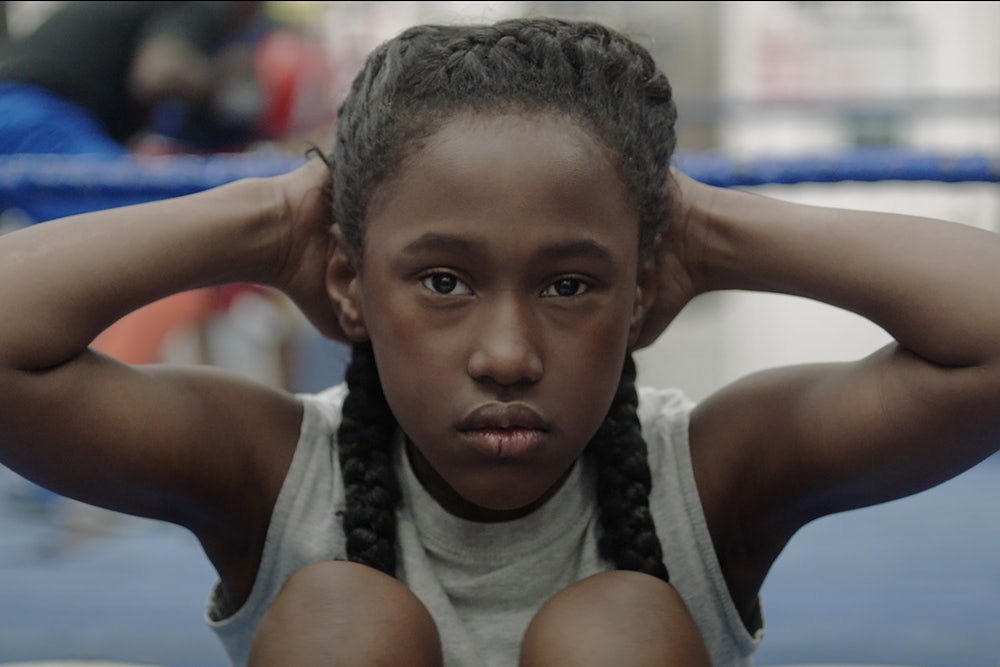When we look back on our adolescence, it can be easy to assign a neat narrative arc—a beginning, middle, and end—to that period in our lives, as if the experiences that happened back then aren’t informing the interactions we’re having right now. The immediacy, mystery, and strange unease coursing through The Fits swats away those tidy illusions. Neither cutesy nor needlessly bleak, the debut narrative film from writer-director Anna Rose Holmer possesses a refreshingly intimate, honest tone about those developmental years, chronicling the seemingly minor travails of an eleven-year-old girl whose desire to belong opens up a door to a world from which she might not return. In Holmer’s hands, the anxiety of adolescence is a lifetime condition.
The film stars newcomer Royalty Hightower as Toni, a tween living in Cincinnati who hangs around the local boxing gym frequented by her older brother Jermaine (Da’Sean Minor), who appears to be the biggest influence in her young life. (It’s telling that adults are almost never seen in The Fits—in the poor African-American neighborhood where the film is set, our adolescent characters are very much on their own.) Training with Jermaine or shadowboxing on her own, Toni displays a fighter’s steely toughness and a tomboy’s ability to pass as one of the guys. And yet she often casts an eye toward the confident, muscular movements of the Lionesses, a girls’ dance squad that practices nearby. With some encouragement from her brother, Toni tries out for the Lionesses, forcing her to recondition her bruising athleticism so it can fit with the squad’s tight, frenetic choreography.
That setup might suggest that The Fits will be a crowd-pleasing sports movie in which a plucky underdog becomes an unlikely dance champion. But Holmer resists the trite narrative path. Instead, her movie is stark as a documentary but also vaguely off-kilter, as if something ominous awaits just around the corner. Toni lacks the polish of the Lionesses’ star performers—played by members of Cincinnati’s Q-Kidz Dance Team—and so her awkward learning curve is painfully visible, a physical manifestation of the insecurities rampant once hormones start wreaking havoc on young people. But even worse, just as Toni is starting to feel a little more comfortable with her new friends, a mysterious illness begins affecting the team’s leaders and older members, causing them to collapse into uncontrollable shaking fits.
In the world of The Fits, a film that prefers atmosphere to straight answers, the rash of epileptic-like episodes is at first an odd anomaly and then a growing concern. We hear the squad’s adult supervisor, whose face we don’t see, mention something about a tainted water supply, but soon even that flimsy excuse proves insufficient. Panic never overtakes Toni or the movie, but there’s a low-level disquiet that seeps into every scene, a product of the many forces our protagonist can’t control. The unexplained attacks are The Fits’ most shocking development, but it’s handled with the same stripped-down nonchalance that greets more ordinary moments, such as Toni’s decision to pierce her ears by herself. Drawing from real-life cases of mass hysteria among teenage girls, Holmer seems to be suggesting that, for girls, the path to adulthood is fraught with so many dangers that a mysterious, possibly contagious shaking fit is just one more obstacle along the way.
Because boys are so often the stars of onscreen coming-of-age dramas, the fact that The Fits centers on a girl is novel in and of itself. But while Holmer focuses on specific female adolescent anxieties—the fear of being sexy enough, as well as the fear of having to change in order to be considered desirable—she leaves room for all kinds of societal pressures to be represented. Without being didactic about it, The Fits speaks to issues of race and working-class realities, invisibly tying Toni’s journey to larger struggles that extend far beyond childhood—the struggle to be accepted, to discover your authentic self, to find your tribe, to stay a step ahead of the unpredictable disasters that can upend your life.
As Toni, Hightower (who has been a member of the Q-Kidz since she was six) gives a perfectly unselfconscious performance, one that favors silence over emoting. The Fits runs about 70 minutes, and for much of it she’s either moving or observing, playing Toni as a kid who’s learned to keep her head down and blend in. But Hightower is no cipher: Throughout, we sense her character’s intelligence and nervousness, quietly taking in information and absorbing it. Perhaps most remarkably, she’s able to portray Toni’s transformation from a rough-hewn dancer into a confident one, arms and legs moving with a sinewy precision that doesn’t convey catharsis so much as it communicates a visceral frustration with a life spent searching for something somehow out of reach.
Unsurprising for a film that eschews the manipulative conventions of the coming-of-age drama in favor of a more muted approach, The Fits doesn’t really build to any grand crescendos or major insights. But the modesty of the movie’s design has its own sneaky power, especially once those shaking episodes become more widespread in the dance troupe. Some sort of unseen force seems to be preying on these girls, starting with the oldest, and Toni embraces what appears to be her destiny with a stone-faced resolve. The Fits doesn’t specify what’s happening, and so the movie’s weird phenomenon starts to feel like a universal threshold of adolescence—a fate that’s both terrifying and strangely normal.
Grade: B+
Looking for more movie recommendations? Check out the latest episode of the Grierson & Leitch podcast.
Grierson & Leitch write about the movies regularly for the New Republic and host a podcast on film, Grierson & Leitch. Follow them on Twitter @griersonleitch or visit their site griersonleitch.com.
